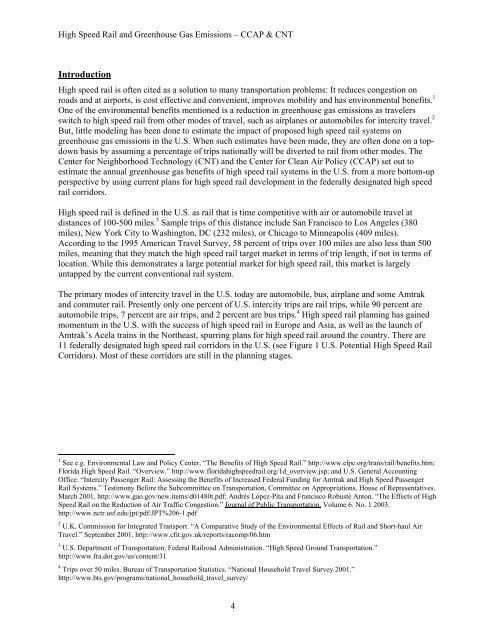High Speed Rail - Center for Neighborhood Technology
High Speed Rail - Center for Neighborhood Technology
High Speed Rail - Center for Neighborhood Technology
Create successful ePaper yourself
Turn your PDF publications into a flip-book with our unique Google optimized e-Paper software.
<strong>High</strong> <strong>Speed</strong> <strong>Rail</strong> and Greenhouse Gas Emissions – CCAP & CNT<br />
Introduction<br />
<strong>High</strong> speed rail is often cited as a solution to many transportation problems: It reduces congestion on<br />
roads and at airports, is cost effective and convenient, improves mobility and has environmental benefits. 1<br />
One of the environmental benefits mentioned is a reduction in greenhouse gas emissions as travelers<br />
switch to high speed rail from other modes of travel, such as airplanes or automobiles <strong>for</strong> intercity travel. 2<br />
But, little modeling has been done to estimate the impact of proposed high speed rail systems on<br />
greenhouse gas emissions in the U.S. When such estimates have been made, they are often done on a topdown<br />
basis by assuming a percentage of trips nationally will be diverted to rail from other modes. The<br />
<strong>Center</strong> <strong>for</strong> <strong>Neighborhood</strong> <strong>Technology</strong> (CNT) and the <strong>Center</strong> <strong>for</strong> Clean Air Policy (CCAP) set out to<br />
estimate the annual greenhouse gas benefits of high speed rail systems in the U.S. from a more bottom-up<br />
perspective by using current plans <strong>for</strong> high speed rail development in the federally designated high speed<br />
rail corridors.<br />
<strong>High</strong> speed rail is defined in the U.S. as rail that is time competitive with air or automobile travel at<br />
distances of 100-500 miles. 3 Sample trips of this distance include San Francisco to Los Angeles (380<br />
miles), New York City to Washington, DC (232 miles), or Chicago to Minneapolis (409 miles).<br />
According to the 1995 American Travel Survey, 58 percent of trips over 100 miles are also less than 500<br />
miles, meaning that they match the high speed rail target market in terms of trip length, if not in terms of<br />
location. While this demonstrates a large potential market <strong>for</strong> high speed rail, this market is largely<br />
untapped by the current conventional rail system.<br />
The primary modes of intercity travel in the U.S. today are automobile, bus, airplane and some Amtrak<br />
and commuter rail. Presently only one percent of U.S. intercity trips are rail trips, while 90 percent are<br />
automobile trips, 7 percent are air trips, and 2 percent are bus trips. 4 <strong>High</strong> speed rail planning has gained<br />
momentum in the U.S. with the success of high speed rail in Europe and Asia, as well as the launch of<br />
Amtrak’s Acela trains in the Northeast, spurring plans <strong>for</strong> high speed rail around the country. There are<br />
11 federally designated high speed rail corridors in the U.S. (see Figure 1 U.S. Potential <strong>High</strong> <strong>Speed</strong> <strong>Rail</strong><br />
Corridors). Most of these corridors are still in the planning stages.<br />
1 See e.g. Environmental Law and Policy <strong>Center</strong>, “The Benefits of <strong>High</strong> <strong>Speed</strong> <strong>Rail</strong>.” http://www.elpc.org/trans/rail/benefits.htm;<br />
Florida <strong>High</strong> <strong>Speed</strong> <strong>Rail</strong>. “Overview.” http://www.floridahighspeedrail.org/1d_overview.jsp; and U.S. General Accounting<br />
Office. “Intercity Passenger <strong>Rail</strong>: Assessing the Benefits of Increased Federal Funding <strong>for</strong> Amtrak and <strong>High</strong> <strong>Speed</strong> Passenger<br />
<strong>Rail</strong> Systems.” Testimony Be<strong>for</strong>e the Subcommittee on Transportation, Committee on Appropriations, House of Representatives.<br />
March 2001. http://www.gao.gov/new.items/d01480t.pdf; Andrés López-Pita and Francisco Robusté Anton. “The Effects of <strong>High</strong><br />
<strong>Speed</strong> <strong>Rail</strong> on the Reduction of Air Traffic Congestion.” Journal of Public Transportation. Volume 6. No. 1 2003.<br />
http://www.nctr.usf.edu/jpt/pdf/JPT%206-1.pdf<br />
2 U.K. Commission <strong>for</strong> Integrated Transport. “A Comparative Study of the Environmental Effects of <strong>Rail</strong> and Short-haul Air<br />
Travel.” September 2001. http://www.cfit.gov.uk/reports/racomp/06.htm<br />
3<br />
U.S. Department of Transportation, Federal <strong>Rail</strong>road Administration. “<strong>High</strong> <strong>Speed</strong> Ground Transportation.”<br />
http://www.fra.dot.gov/us/content/31<br />
4 Trips over 50 miles. Bureau of Transportation Statistics. “National Household Travel Survey 2001.”<br />
http://www.bts.gov/programs/national_household_travel_survey/<br />
4



